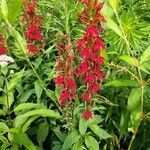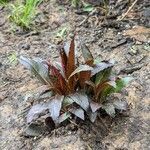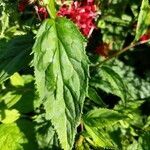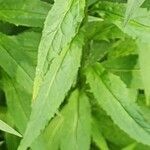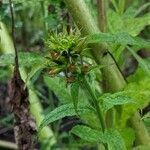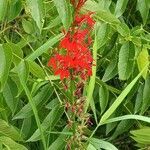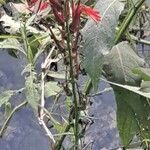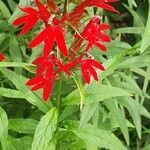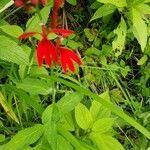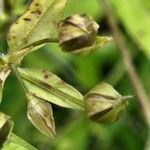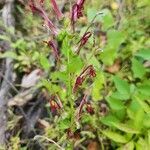Herbs 0.4-1.5(-2.0) m tall, usually perennating by offsets; stems erect and unbranched, glabrous to densely pubescent. Cauline leaves 10-30, spreading, relatively thin or papery when dried, glabrous to densely short-pubescent, sub-entire to coarsely beset with callose-tipped teeth, linear, lanceolate, oblong or ovate, usually apically acute, basally tapering or the lower leaves with a petiole to 3 cm long. Inflorescences 15-30(-50) cm long, not especially secund, with few-100, loose to densely clustered flowers 3-S cm long; pedicels more or less erect, slender, 4-15(-20) mm long, glabrous, spiculate, or short-pubescent, basally bibracteolate, the filiform bracteoles mostly 1-2 mm long, subtended by linear and small, sometimes leafy bracts; hypanthium conic to campanulate, glabrous to densely spreading short-pubescent, mostly 8-11 mm in diameter; calyx lobes en-tire, linear, glabrous or stiffly ciliate especially basally, 8-16(-20) mm long; corolla scarlet, deep crimson or red, or rarely pink to white, usually externally puberulent, the lip glabrous, the tube usually 15-20 mm long, fenestrate, the upper 2 corolla lobes linear, erect, 13-20 mm long, 1-2 mm wide, the 3 lower lobes de-flexed, ovate, acute, 13-20 mm long, (2-) 3-4 (-9) mm wide; filaments 19-33 mm long, longer than the corolla tube, glabrous to densely spreading short-pubescent, connate distally for more than half their length, the anther tube bluish gray, the 2 shorter anthers 2.2-2.7 mm long, bristly white-tufted with trichomes 0.8-1.2 (-1.5) mm long, the 3 longer anthers 3.5-4.5(-5.5) mm long, glabrous to moder-ately bristly pubescent. Capsules about half interior, usually 6-8(-10) mm high; seeds linear-oblong, light brown, 1.0-1.2 mm long.
More
Erect, usually unbranched, 5–15 dm, ± hairy or largely glabrous; lvs thin, lanceolate to oblong, to 16 × 5 cm, acute or acuminate, dentate, mostly 3–5 times as long as wide, the lower short-petioled, the upper smaller, sessile or nearly so; racemes 1–4 dm; bracts linear or narrowly lanceolate; pedicels hairy, 5–15 mm, bibracteolate at base; fls 3–4.5 cm, scarlet (rarely pink to white), the lower lip glabrous within; sep linear, 8–12 mm; auricles none or minute; 2n=14. Wet soil; N.B. to Minn., s. to the Gulf of Mexico. July–Sept. Our plants, as described above, are var. cardinalis.
A herb. It grows 20-30 cm tall. The leaves are dark green and purple underneath.
Can be grown by cuttings or seedlings. Seeds needs stratification.
